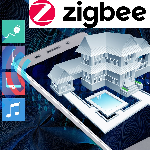Building a Smarter Home with a Zigbee Hub
To build a smart home can be an exciting experience. Nevertheless, sometimes you can feel overwhelming with so many devices and brands to chose in the market. When you start building your smart home, you might be tempted to buy individual smart gadgets like a smart bulb here, a smart plug there, but as your home automation grows, you’ll quickly realize that the compatibility and integration between devices can become a challenge. That’s where a Zigbee hub comes in.

Zigbee protocol has become a communication standard for smart homes that allows devices from various brands to work together. A Zigbee hubs will allow you to integrate all your smart home devices, ensuring everything works smoothly.
If you’re thinking to start with your home automation journey, but at the same time you have plans to expand your smart home in the future, a Zigbee hub could be the perfect solution to ensure everything stays connected as your setup grows.
We’ll explain how Zigbee works, why a Zigbee hub is worth it when building your smart home and the major brands and devices on the market.
What is Zigbee?
Zigbee is a wireless communication protocol that allows smart home devices, such as lights, locks, sensors, and more, to connect and interact with each other. Unlike Wi-Fi, which is typically designed for heavy data traffic like streaming and browsing, Zigbee is optimized for small data transfers and low energy consumption, which make it perfect for battery-powered smart home devices that don’t need heavy data transfer.

Think of Zigbee as a “language” that smart devices speak to each other. It creates a mesh network, meaning that each Zigbee device can pass messages to others, extending the range and reliability of your network. This mesh feature ensures that if one device loses connection, others can help maintain communication, making your home automation system more stable and resilient. Zigbee devices communicate with each other through a Zigbee hub, which is also often called a coordinator or a Zigbee gateway.
Originally developed as a standard for wireless data networks in the 1990s, Zigbee has become widely used in home automation, industrial systems, and medical applications. Whether you’re looking to connect a few devices or planning to expand your home automation in the future, Zigbee provides the infrastructure to keep everything running smoothly
To learn everything about the Zigbee Protocol Specification check the Connectivity Standar Alliance at CSA-IOT.org
Why Use Zigbee in Your Smart Home?
Zigbee offers lot of benefits that make it the go-to solution for building a connected, reliable, and scalable smart home, even more with the release of the new Zigbee 3.0 protocol which adds features to the standard version improving security, and offering new network topology options for the different brands product implementation Here are some key reasons why Zigbee should be part of your smart home setup:
- Low Power Consumption: Zigbee devices don’t consume so much, which make them ideal for battery powered devices like sensors and locks.
- Stability (auto recovery): Zigbee’s mesh network ensures continuous communication, rerouting data if a device goes offline.
- Security: Uses AES-128 encryption, providing a robust security to your home devices data.
- Scalability: Supports up to 65,000 devices in a single network, which allows you to expand smart home devices networks without almost any restriction.
- Integration: Zigbee devices are compatible with various major brands like Philips Hue, Yale, Samsung SmartThings, Amazon Echo… which allows and easy integration between their products (lights, motion sensors, locks, security cameras…)
- Software Updates (OTA): Zigbee supports over-the-air (OAT) feature, allowing easy software updates to keep devices up to date.
- Low Data Rate: Zigbee operates with a low data rate, making it perfect for devices that just require to send a small amount data like sensors.
- Flexibility (Multiple Topologies): Zigbee offers various network topologies, which gives you flexibility in how you set up your smart home network.
- Low Latency: Zigbee offers minimal delay, making it perfect for quick transmissions.
How Zigbee Works in a Smart Home
When you build a smart home, the goal is to create an ecosystem where all your devices work together. Zigbee is a wireless protocol that makes this integration possible, acting as the backbone of your home automation system. Let’s break down how Zigbee works within your smart home, making it easier for you to manage and control various devices.
Zigbee Hub: The Central Control Point
At the heart of any Zigbee-powered smart home is the Zigbee hub (also called a coordinator or gateway). Think of the hub as the brain of your setup. It manages communication between all Zigbee devices in your home and ensures they can communicate between them. The hub connects to your home’s Wi-Fi network or other control platforms like Alexa or Google Assistant, allowing you to control your Zigbee devices from a single app or through voice commands.
Zigbee Mesh Network: End Devices Act as a Router
One of Zigbee’s best features is what they call the mesh network. Unlike traditional point-to-point communication, where devices connect directly to one another, Zigbee create a mesh network where each device can act as a zigbee router or zigbee repeater. This means that when you add more devices, you improving the reliability of your network.

Each device in a Zigbee mesh network can send messages to other devices, extending the range and improving connectivity.
Zigbee Device Communication:
Zigbee devices talk to each other by sending small data packages through the mesh network. Zigbee uses a low data rate which is ideal for simple tasks like controlling lights, motion sensors, or checking door locks. In addition the low bandwidth requirement helps to conserve the battery life of your devices.
Data security is a top priority in Zigbee networks. To protect sensitive information, Zigbee uses AES-128 encryption. This ensures that your smart home devices communicate in a secure way, reducing the risk of cyber threats and unauthorized access.
What Devices Use Zigbee?
The Zigbee protocol is widely adopted in smart homes. A Zigbee hub can manage and coordinate a wide range of devices, creating a robust Zigbee mesh network (refer to “How Zigbee Works in a Smart Home” in this article). From lighting and heating systems to security and entertainment, a Zigbee gateway offers a perfect ecosystem of connected products. Some examples of Zigbee devices you can integrate into your smart home:
- Zigbee light switches and smart Zigbee bulbs for home lighting: With Zigbee light bulbs and smart light switches, you can easily control your home’s lighting (turn on/off lights, adjust the brightness or even change the colour of the lights).
- Zigbee plugs for non-smart appliances: Unlike Zigbee switches, which control specific areas in your home, Zigbee plugs allow you to remotely control non-smart appliances or devices. This expands your smart home integrating your existing non-smart devices into your Zigbee mesh network.
- Zigbee smart locks and Zigbee cameras for home security: Zigbee’s low-power consumption is ideal for securing doors and gates with smart locks, allowing remote locking/unlocking and even granting temporary access codes for guests. Zigbee cameras also enhance security, providing real-time monitoring and alerts.
- Zigbee motion sensors for automation: Zigbee motion sensors detect movement and can automate actions like turning on lights, triggering security alarms, or adjusting thermostats to save energy.
- Zigbee thermostats and Zigbee temperature sensors for home heating: Zigbee thermostats and temperature sensors ensure your home remains comfortable, adjusting heating or cooling automatically to suit your preferences.
Major Zigbee Brands and Manufacturers
Zigbee is supported by some of the biggest names in smart home technology. Many well-known manufacturers have integrated the Zigbee protocol into their products and offer their own Zigbee gateways, ensuring broad compatibility and ease of use. Some major brands that use Zigbee include:

- Philips Hue: Known for its variety of smart lighting product. Although they offer all kind of zigbee devices for smart homes, Philips Hue stands out for their Zigbee bulbs, zigbee switches and zigbee plugs that can be used for your home lighting.
- Samsung SmartThings: One of the most popular smart home ecosystems, SmartThings offers a variety of Zigbee devices, including sensors, locks, and lights.
- Somfy: Specializes in motorized window coverings and home automation. Somfy’s Zigbee compatible products include smart blinds and curtains, which can be controlled from the Zigbee hub to integrate them with other smart home devices.
- Lutron: A leader in lighting solutions, Lutron provides different models for zigbee bulbs and zigbee switches.
- Huawei: Known for its tech and networking products, Huawei also offers Zigbee solutions for smart home ecosystems. Their smart home devices include sensors, cameras, and lighting which integrate well into a Zigbee network.
- Amazon: Amazon integrates Zigbee into its Echo devices, such as the Echo Plus and Echo Show, enabling direct control of Zigbee smart devices like lights, thermostats, and locks through voice commands with Alexa.
- Google: Google Nest devices, including thermostats, cameras, and doorbell systems, use Zigbee as well for smooth integration with other smart home products.
- Apple: Apple HomeKit supports Zigbee through compatible hubs and devices. With Apple’s ecosystem, users can control Zigbee devices, using Siri voice commands.
With so many brands compatible with Zigbee, you can be sure you won’t have any problem expanding your smart home in the future.
To learn more about smart home integrations and the benefits that a centralised integration with a Zigbee gateway can provide read: “Smart Home Lighting“, “Smart Switches vs. Smart Bulbs and Plugs: A Comprehensive Guide to Home Automation“, “Transform Your Home with Smart Motion Sensors: Use Cases and Top Products”
Zigbee Hubs Future: What It Means for Your Smart Home
To summarised, a Zigbee hub is a powerful, cost effective, and energy efficient solution for smart homes. With its low power consumption, robust security features, and scalability, Zigbee assure that you will be able to expand your smart home as you need. Its compatibility with devices from major brands like Philips, Samsung, and Amazon among others, ensures that Zigbee can integrate into a wide variety of smart home products and ecosystems.
If you’re looking to build or expand your smart home, Zigbee devices are an excellent choice. Their affordability, efficiency, and security will help you create a connected and automated home that will make your life easier.

